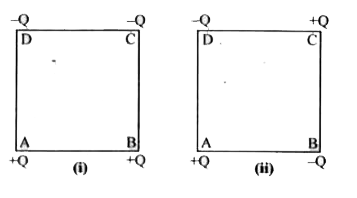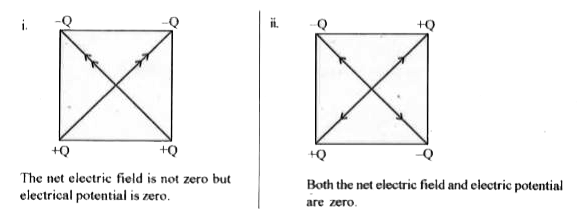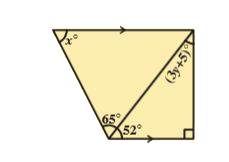Four point charges are placed at the four corners of a square in the two ways (i) and (ii) as shown below: Will the
i. electric field
ii. electric potential, at the centre of the square, be the same or different in the two configurations and why?  Solution in Tamil
Solution in Tamil
i. 
Topper's Solved these Questions
- ELECTROSTATIC POTENTIAL AND CAPACITANCEBOOK - NEW JOYTHI PUBLICATIONCHAPTER - ELECTROSTATIC POTENTIAL AND CAPACITANCEEXERCISE - Previous Year Questions
2 Videos
- ELECTROSTATIC POTENTIAL AND CAPACITANCEBOOK - NEW JOYTHI PUBLICATIONCHAPTER - ELECTROSTATIC POTENTIAL AND CAPACITANCEEXERCISE - Competitive Exam Corner
22 Videos
- ELECTROSTATIC POTENTIAL AND CAPACITANCEBOOK - NEW JOYTHI PUBLICATIONCHAPTER - ELECTROSTATIC POTENTIAL AND CAPACITANCEEXERCISE - Practice Problems For Self Assessment
23 Videos
- ELECTROMAGNETIC WAVES BOOK - NEW JOYTHI PUBLICATIONCHAPTER - ELECTROMAGNETIC WAVES EXERCISE - COMPETITIVE EXAM CORNER
16 Videos
- MAGNETISM AND MATTERBOOK - NEW JOYTHI PUBLICATIONCHAPTER - MAGNETISM AND MATTEREXERCISE - COMPETITIVE EXAM CORNER
13 Videos
Similar Questions
A. A device to store electrical charge is called
a. Transformer
b. Capacitor
c. Resistor d. Inductor
B. What is meant by energy density of a parallel plate capacitor?
C. Derive an expression for the energy stored in a parallel plate capacitor.
D. What is the area of the plates of a 0.1μF parallel plate air capacitor, given that the separation between the plates is 0.1 mm.
View SolutionFrom the figure find x and y.

View SolutionCalculating the work done in eV in carrying a charge +e Coulomb through a potential rise of 100 volts. (1.0eV=1.6×10−19joules)
View SolutionIf the total electromagnetic energy falling on a surface is U, then the total momentum delivered (for complete absorption) is
View SolutionChoose the correct statement .
View SolutionFour point charge are placed at the corners of a square with diagonal 2a as shown. What is the total electric field at the center of the squre?

View SolutionFour electrical charge are arranged on the corners of a 10cm square as shown. What would be the direction of the resulting electric field of the resulting electric field at the center point P?
View SolutionFour electric charges +q, +q, -q and -q are placed at the corners of a square of side 2L (see figure). The electric potential at point A , mid-way between the two charges +q and +q , is
View SolutionFour idential charges each of charge q are placed at the corners of a square .Then at the centre of the square the resultant electric intensity E and the net electric potential V are
View SolutionFour charges are arranged at the corners of a square as shown in the figure. The direction of electric field at the centre of the square is along
View SolutionIn vacuum, four charges each equal to q are placed at each of the four vertices of a square. Find the intensity and potential of the electric field at the point of intersection of two diagonals.
View SolutionFour charges, all of the same magnitude, are placed at the four corners of a square. At the centre of the square, the potential is V and the field is E. Which of the following are possible?
View SolutionFind the electric field and potential at the centre of a square of side d = 10 cm. Four identical charges of q=2muC each are kept at the four corners of a square.
View SolutionFour point charges of +1muc each are placed on the four corners of a square of side 1 m. Calculate the electric potential at the centre of the square.
View SolutionFour point charges are placed at the four corners of a square in two ways (a) and (b) [Chin 3.45]. Will the positions of (a) the electric field and (b) the electrical potential at the center of the square be the same or different and why?
View Solution